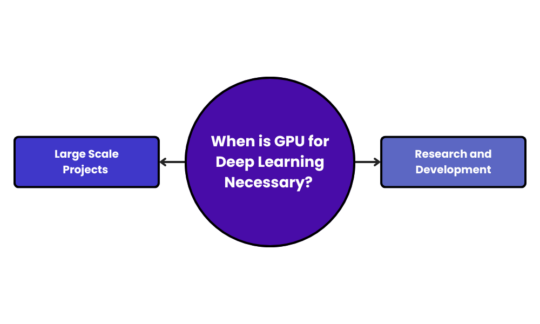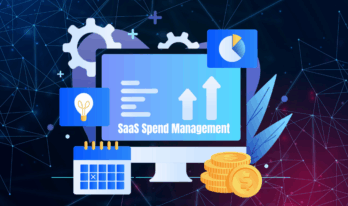Ever tried to imagine how computers learn to recognize faces, interpret speech, or even navigate cars? Deep learning is usually the key to all these feats, and this technology works exactly like the human brain. Central to most deep learning procedures is a specific instrument known as a GPU or graphics processing unit. So, what is GPU, and why does it play such a central role?
In this blog, we will dive into the world of GPUs, exploring GPU for deep learning and whether they are a must-have or just a helpful addition. Let's simplify this topic and make it more engaging.
What is GPU?
The Graphics Processing Unit, or GPU, is a type of computer chip. GPU is designed to do a lot of tasks at a time, just like a CPU (Central Processing Unit). This multitasking capability makes GPU perform many calculations and is effective for processing graphics and complex math. This makes GPUs useful for deep learning. For example, sources reflect that, the NVIDIA RTX 4090 is one of the top GPUs for deep learning and offers 82.6 teraflops of performance. This makes it faster than previous generations.
Deep Learning: A Quick Overview
Deep learning teaches computers to learn from large amounts of data. It works the way humans learn. It uses models called neural networks. These networks require a lot of calculations, which is why GPUs are so important, as they help to speed up the process.
For instance, around 90% of deep learning researchers and practitioners use NVIDIA GPUs as they perform superior and give extensive software support.
Why Use GPU for Deep Learning?
Speed Matters
Speed is one of the biggest benefits of using a GPU for deep learning. Training deep learning models is time-consuming, especially when working with large datasets. GPUs can perform many calculations at once. This increases the speed of the training process. This means you can get your results faster and adjust your models without waiting for days.
Handling Large datasets
Deep learning usually requires working with large amounts of data. For example, if you are training a model to check the images from a large database. A GPU can process this data more efficiently than a CPU. This allows you to train more complex models that can learn and interpret better.
Improved Performance
Using GPU for deep learning improves performance in your models. As they have the ability to process the data faster and perform complex calculations, GPUs produce accurate models. This means your deep learning applications, like image recognition or natural language processing, will work better with a GPU.
Are There Any Alternatives?
CPUs: The Traditional Option
Although GPUs are a strong option, they are not the only choice. Older CPUs may be utilized for deep learning as well. For simple models or small datasets, a CPU works very well. If you have just started working on a small project, a CPU will meet your needs without any issues.
TPUs: A New Player
Another option is the TPU (Tensor Processing Unit), which is specially designed for deep learning tasks. TPUs perform better than GPUs for deep learning in many places, especially in cloud computing environments. However, they are not nearly as accessible for individual usage as GPUs.
When is GPU for Deep Learning Necessary?
Large Scale Projects
If you are dealing with massive deep-learning projects, a GPU is indispensable. For instance, firms working on autonomous vehicles or sophisticated medical imaging applications are completely dependent on GPUs. Their performance and speed are the most important aspects of such applications.
Research and Development
Researchers have to test various models at a time. A GPU can accelerate the process. It allows researchers to adjust and create without being constrained by lengthy training times.
When is GPU Optional?
Small Projects
For beginners or small projects, a GPU for deep learning might not be necessary. If you are new to deep learning and have small datasets, a CPU will do the work. You can upgrade to a GPU at any point as your projects increase.
Budget Constraints
GPUs are costly. If you are on a tight budget or are just beginning, you may prefer to stick with a CPU. There are enough tutorials and resources out there that can teach you and allow you to experiment without a high-end GPU.
Choosing the Right Path!
So, is GPU for deep learning necessary or optional? It all depends on your needs. If you are working on large projects or research, a GPU is important. However, for small projects or learning purposes, it is optional.
Overall, understanding your budget and goals will help you to make the right choice. Whether you choose to invest in a GPU or stick with a CPU, the most important thing is to keep learning and exploring the exciting world of deep learning!
For more such informative blogs, visit WisdomPlexus!
FAQ
Q: What is a GPU?
Ans: A GPU, or Graphics Processing Unit is a chip that can do many calculations at a time. It is great for graphics and heavy tasks like deep learning.
Q: Is GPU necessary for deep learning?
Ans: No, a GPU is not always needed for deep learning. However, it helps train the models much faster by having a big dataset.
Q: Is GPU mandatory for AI?
Ans: No, there is no need for a GPU for AI. You can use a CPU for small tasks, but a GPU will make bigger projects run faster and better.
Recommended For You:





